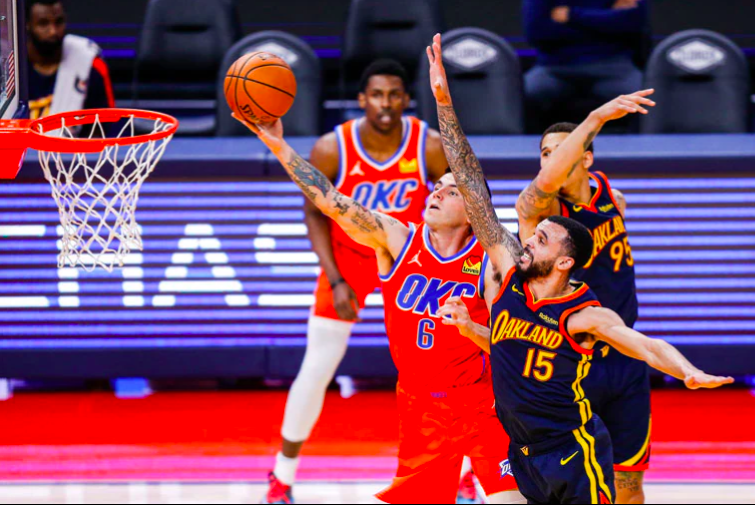Breaking down Gabriel Deck’s feel for the game, unique skillset and his NBA future

Hours after Gabriel Deck scored 19 points to help Real Madrid clinch a EuroLeague playoff spot, news broke that Oklahoma City was waiving 5-year NBA veteran Darius Miller to create a roster spot for the 26-year-old Argentinian forward.
The signing came as a surprise to many, as the Thunder signed Deck to a 3-year, $14.5 million dollar contract (non-guaranteed on years 2 & 3).
As excitement grew, I went straight to Youtube to watch Gabriel Deck highlights — You could see why the Thunder were interested. Deck, an undersized 6-foot-6 forward, was the definition of a “winning player.” A tough and gritty Argentinian with a strong all-around feel for the game — which seems to fit the mold of what Sam Presti wants in the next iteration of Oklahoma City Basketball.
Deck only played 10 games in the NBA, which is an extremely small sample size that isn’t enough to fairly judge a player.
There were also a number of other unusual factors, including the language barrier (Deck doesn’t speak english), lack of practice time, speed of the game and the fact that he wasn’t on any NBA scouting reports. I say all of this to remind everyone to take everything with a grain of salt, both the good and the bad.
I highly value the overall feel a player has. Deck is 26 years old. At this stage of his career, It will be much harder to develop feel than it would be for an 18-year-old rookie. He has been playing professional basketball since he was 14, at this point his brain is programmed to a certain extent and developing feel would be much more difficult. Which is why I value “feel” so much with him because it would be much more difficult to develop if he was lacking that skillset.
We’ll start out by showing off his amazing feel for the game. Deck’s feel is the strongest skill set he has. If this part was lacking he would most likely not be an NBA player, might not even be playing for Real Madrid.
The three main components of feel that we will be looking at for Deck is pattern recognition, visual processing, and processing speed.
Many of Deck’s amazing passes seemed to come from instincts. Especially all of his fajitas (behind the back passes)! While others seem to come from him thinking the situation out, staying patient and not rushing or panicking when met with an uncomfortable situation on the court.
Deck played with no practices, no chemistry with teammates, and barely able to really communicate with them. When asked about Deck and his inability to communicate with teammates due to the language barrier Daigneault said, “He understands English in a basketball context, but speaks fluent Spanish. What’s helpful is he’s played at a high level for a long time and basketball is a universal language.”
Here’s a couple clips where that’s easy to see:
Here we have two completely different scenarios. In the first clip he is easily able to quickly recognize Hayes stepping up with Zion on the dunker’s spot and he is able to get the pretty behind the back pass. It’s simple, but effective & also shows off his proprioception.
In the second clip we are able to see him recognize the P&R. He is sagging off Mikal on the wing and tags the roll man which leads to him getting the steal. Now, this is where we see him stay composed and instead of driving and taking a bad shot in transition, he slows it down. He’s able to use the fake pass to the wing, attacks the basket where Ayton rotates and he is quickly able to hit Bradley for the dump off.
He has shown the ability to fully understand what is going on in the game at all times and is able to quickly react. The Argentinian National Team plays high tempo basketball. That means lots of baskets in transition which has helped Deck quickly process different things.
Timing is incredibly important and one skill that is usually overlooked is the ability to cut to the basket at the correct times. Something that Deck has shown to be a strong part of his game.
This may be one of the best clips from his time in OKC. It shows off how he reads the defense and how he is able to read the defender for the perfect cut to the basket. Right before Deck cuts you can see Hield look over to him for a split second before Hield shifts his attention back to Kenrich Williams. The second Kenrich begins penetrating the defense, Deck cuts to the basket.
He understands that Hield’s attention is focused on the ball and Hield will most likely have to step-over to help on Kenny, which leads to a bucket for Deck.
Here’s another example:
Deck once again is able to get behind his defender and cuts to the basket. Receives a beautiful bounce pass from Poku and Tony Bradley’s man is forced to rotate to help on Deck & he is able to quickly recognize this and hit Bradley with a pretty fajita.
So many things are happening during this play. The part that impresses me the most is how quickly he is able to understand the situation in front of him and how he processes it. Two seconds. That is the amount of time that passes from when he cuts to the basket to Tony Bradley dunking the ball. For him to realize that Bradley is open and quickly move the ball from his right hand to his left hand for the behind-the-back pass is impressive.
Now, Let’s talk about Gabriel Deck’s complicated jumpshot and the mechanics of it. I think there are many things that make a shooter a “good shooter” such as shot variability, perception, mechanics, proprioception, hand-eye coordination, touch, and confidence.
Gabriel Deck’s jumper is unconventional and completely throws me off. He barely leaves the ground on his stationary jumper and has a huge hitch once he puts the ball over his head.
Now, hitches and two-motion jumpers work fine when you are just catching and shooting the basketball. The problem is when you attempt off-the-dribble jumpers, it limits you to an extent. For example, Shai had a two-motion jumper for the first two years of his career and has almost completely taken the hitch out of his shot. This has led to him being able to take jumpers off of screens and has helped his shot variability. The interesting part about Deck is his hitch becomes less noticeable depending on the type of jumper he takes but there isn’t much consistency to it. Some pull-up jumpers have no hitch, while others have minimal hitch. When he is shooting post-up faders you often see no hitch at all or a slight double clutch.
Here’s a few examples:
Deck’s shooting is still somewhat unknown. While he shot 41 percent in his final season at Real Madrid, in his 10 games in OKC he shot 13 percent on 1.5 attempts per game.
10 games is such a small sample size. It’s so small that it shouldn’t even be considered a sample size but a few things that could have caused this is the quality of shots he was taking, personnel and spacing.
Deck has numerous different types of jumpers and I am a firm believer in taking a slightly below average shooter who has a wide range of jumpers in his arsenal as compared to a slightly above average shooter who is strictly catch-and-shoot. Deck has most of the attributes that I think good shooters need. I don’t see a realistic scenario where he shoots high 30-low 40 percent, but if he can be league average and shoot high 30 percent from the corners he will be an effective player for Oklahoma City.
Deceptive athleticism has become a joke when describing prospects but Deck truly is deceptively athletic. He doesn’t have a lot of traditional athleticism, but he does have enough to be able to manipulate defenders and hit a burst of speed to get him a basket at the rim and has enough jump and body control to be an above average finisher at the rim.
The last part of Deck’s game that we will touch on is his infamous post and mid-range game. When you think of great post-up guards in the league’s history you think of Kobe, Jordan or even LeBron. All three of them were so dangerous in the post because of how dangerous their fadeaways were and their great footwork.
Deck’s style couldn’t be more different. While his footwork is impeccable, he usually bullies the opposing teams guard, backing them down until he has them right where he wants them and that’s when he attacks for a turnaround jumper.
In his 10 games in OKC, he scored on 75 percent of his post-ups and averaged 1.5 points per possession on them. Deck shot 58 percent on his mid-range shots which puts him at the 99 percentile for forwards in the NBA according to Cleaning The Glass (once again, take these numbers with a grain of salt due to the small sample size).
Many times, OKC ran different offensive sets and off-ball actions to give Deck an iso post up situation on one side of the court. The most impressive part was Deck’s ability to facilitate from the post. His awareness and perfect timing set defenders up. If anyone helped over he would kick it out and more often than not, the possession would end with a deep 3-pointer from Ty Jerome.
Deck’s future
Deck’s future on the Thunder and in the NBA is a bit tricky. He is already 26, has an offensive game that seems like it is straight out of the late 90’s/early 2000’s and the Thunder’s roster is already looking like it might be even more clogged than this past offseason. With all that being said, I feel very confident that Deck will be here next season if he wants to be.
Sam Presti gushed about Deck in his exit interview. He discussed how they’ve liked Deck for a while now, called him a winning player and said that he, just like other Argentinian players, brings something special to teams.
It doesn’t make sense that they would go through the troubles of signing a player from Spain and going through all of the hoops like the contract buyout (Deck reportedly paid $2 million to buyout his contract), immigration, and the language barriers for a 10 game glorified tryout.
Mark Daigneault discussed how they were more-than-pleased with Deck as well and Deck said that he will be working out in Oklahoma City until it is time to join the Argentina National team for Olympic camp.
He will most likely have a similar role if not more reduced down to about 15 minutes a game but I think Deck’s signing is a sign that Sam Presti is straying away from the stereotypical athletic player that is lacking feel and any type of jump shot. We’ve known for a long time that Sam has always admired the Spurs. From their style of play to how they run their organization. Players like Deck, Maledon and Jerome are pointing more towards OKC moving that direction when it comes to role players off the bench.
Time will tell what his career turns out to be and whether or not he will be back overseas next year but with the direction that the team is going with their style of play, I’d be shocked not to see Deck in a Thunder jersey next year.


